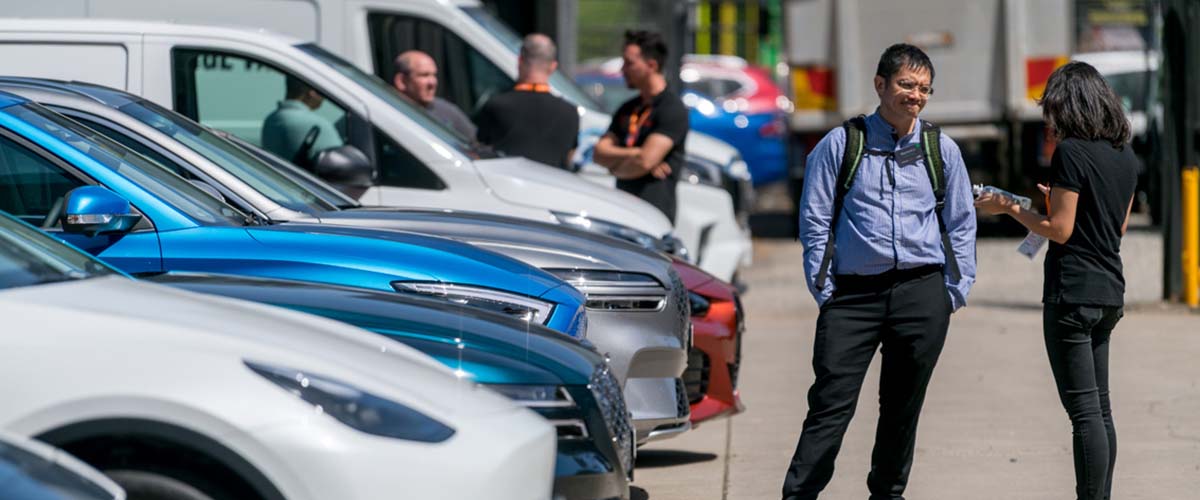As part of our push to make road transport more sustainable (and reduce customer emissions), we’ve been promoting the benefits of electric vehicles to our customers. More EVs on the road means less customer emissions on our roads, and across the entire Australian network.
Recognising fleet managers’ significant buying power and impact on the second-hand vehicle market each year, we hosted our first ever Transurban EV Drive Day in February. On the day, around 50 fleet managers took different EVs out for a spin and heard from industry experts and peers who already have EVs in their fleets. The Transurban EV Drive Day was presented in partnership with Origin and the Australasian Fleet Management Association.
Here’s a summary of what we heard on the day:
- Most fleet vehicles are being charged at home
Origin reported around 80% of EV charging is done at home or work, based on an EV-charging trial Origin has conducted with Australian Renewable Energy Agency funding. Up to 150 smart chargers were supplied to a mix of fleet owners and individual EV owners to learn about EV-user charging behaviours.
The research found that, much like mobile phones, for around 40% of EV drivers, vehicles were plugged in on arriving home. And around 25% of EVs were charged during the day to capitalise on solar power access.
Origin also learned that overnight charging, whether using a smart charger or a regular power-point will get the charging job done for most people. Most vehicles in Australia travel less than 50 kilometres a day according to ABS data, and overnight charging easily covers this travel.
Origin reported a single-phase AC smart charger delivers around 50 kilometres of range per hour of charging, and a standard household 10A power-point delivers around 100 kilometres of range overnight (nine hours of charging).
- EV owners frequently become committed EV enthusiasts
EV owners attending and presenting on the day enthused over the benefits their EVs delivered, including: fuel-cost savings; more enjoyable driving experiences; reduced maintenance costs; and low-cost (and in some cases, at-home) servicing.
- Home-charging isn’t one-size-fits-all
Charging vehicles at home is easy when you have a garage or driveway. Owners can use a wired-in charger or a household power point. Newly introduced rules require new-build Australian apartment buildings to support EV charging infrastructure. But for existing apartments retrofit charging installations are assessed case-by-case. For on-street parking, power-pole charging points are one option being explored. In the meantime, some EV drivers may need to rely on public fast-charging infrastructure.
Tracking electricity costs associated with a vehicle is another challenge when charging direct from a household power point. With a smart charger this is simplified: vehicle energy use can be tracked via the charger, with the power supplier invoicing the company directly. Origin has successfully implemented this approach with fleet customers.
Moving houses doesn’t mean leaving the smart charger behind: chargers can currently be removed and installed at new location for around $1,000.
- EV’s better driving experience may have wellbeing and staff retention benefits
EV drivers often say that, once you’ve made the switch, “you can never go back”. Both fleet managers and EV drivers mentioned anecdotally that the EV driving experience: faster acceleration and quieter operation make driving more enjoyable and relaxing, with some suggesting EVs’ wellbeing benefits could improve staff retention.
- Introducing EVs into fleets requires a change management approach
Shifting to EVs can generate uncertainty among workforces. Establishing a change management strategy to guide the transition will help smooth the road bumps for those who are hesitant. Bringing EV advocates on board early was mentioned frequently as a positive, as was choosing the easiest entry point for your operations – reducing the risk of negative experiences and increasing opportunities for internal success stories.
- Taking a long-term view on charging infrastructure installation can deliver cost-savings
When installing smart-charging solutions, taking a long-term view may be cost effective. For example, getting extra cabling installed at the outset for tie-in as a fleet expands can future-proof operations and installation costs.
More information
Learn more about Transurban’s electric vehicle advocacy.
NSW fleet managers may also be interested in the Origin 360 EV Drive Day for Fleets on 17 and 18 May 2023.

